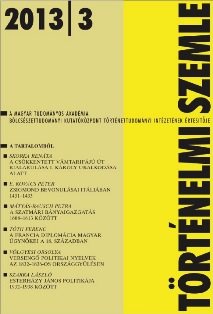Ceremónia és politika. Zsigmond bevonulásai Itáliában 1431–1433
Ceremony and Politics. The Ceremonial Entrées of Sigismund in Italy 1431–1433
Author(s): Péter E. KovácsSubject(s): History
Published by: Magyar Tudományos Akadémia Bölcsészettudományi Kutatóközpont Történettudományi Intézet
Summary/Abstract: In the course of his second journey in Italy, Sigismund of Luxemburg stopped at several places, and was accorded everywhere a reception in keeping with his rank, whether the locality he attended was a rich city or a settlement of inferior standing. Luckily enough, we have detailed information on the circumstances of the ruler’s entering the locality in almost all cases when he spent more than a month at a given place, and we also dispose of bits and pieces from cities where he only reposed for a couple of days. Distinguishing between these two kinds of elements of his itinerary is not only important in terms of documentation, but also because it is indispensable for a joint interpretation of the two terms which figure in the title. To put it very simply: in those places where the king merely stopped for a brief repose, ceremony dominated, whereas in those where he came with the intention of pausing for a longer period, both ceremony and politics played a role. In the present study, I examine the six phases, which are now traditionally accepted in the scholarly literature, with regard to the Italian entrées of Sigismund. These are as follow: 1) the preparations for the arrival (Adventus), 2) the meeting (Occursus), 3) the entrée (Ingressus), 4) ceremonial procession in the city (Processio), 5) visiting the chief church (Offertorium), 6) banqueting. Unfortunately, the nature of our sources makes it only possible to write about the following cities in detail: Milan, Piacenza, Parma, Lucca, Siena, Viterbo, Rome, Foligno, Perugia, Gubbio, Rimini and Ferrara. In knowledge of the information which have come down to us from these cities, we can safely conclude that the phases which are commonly identified in the literature can be recognised in the course of the entrées performed by Sigismund as well. I would also raise a well-known concept in connection with the entrées, namely that of representation, for it is evident from the descriptions that both the ruler and the cities made efforts to present themselves in the best possible light. Although no ideal scheme can be identified in the course of the Italian voyage (with the possible exception of Rome), there is perhaps no need at all to look for it outside the phantasies of historians. No historian can usefully add to the problem of entrées unless there are sources at hand, and he/she manages to fi nd them. When we blame our sources for the lack of beautifully constructed schemes, it is sometimes rather more advisable to beat a retreat.
Journal: Történelmi Szemle
- Issue Year: 2013
- Issue No: 03
- Page Range: 351-380
- Page Count: 30
- Language: Hungarian

